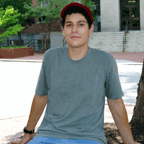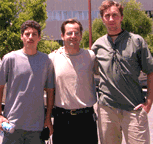CSC News
Moussa Joins IBM's Extreme Blue Internship
 Nader Moussa, a triple-major senior at North Carolina State University, is participating in IBM’s highly competitive Extreme Blue internship program in Austin, Tex., this fall.
Nader Moussa, a triple-major senior at North Carolina State University, is participating in IBM’s highly competitive Extreme Blue internship program in Austin, Tex., this fall.
The computer science, physics and electrical engineering major will be joining a team of computer scientists, including Jacob Yackenovich, who works in IBM’s offices in the Research Triangle but is relocating to Texas for the fall, and Greg Studer, who just graduated from Cornell University, as well as a number of fulltime IBM scientists.
“I’ll be working with Tivoli software to help discover relationships among applications and middleware components on high-performance servers that run Java 2 Enterprise applications, such as those deployed in support of the world's largest commercial Web sites," Moussa says. “I’ll be writing code in Java and hopefully learning something about a corporate environment.”
 This experience follows on the heels of his summer internship at SRI International’s molecular physics laboratory in Menlo Park, Calif.
This experience follows on the heels of his summer internship at SRI International’s molecular physics laboratory in Menlo Park, Calif.
There, he had been working with Dr. Joe Marschall, who selected him “because my transcript had a lot of ‘mathy stuff’,” Moussa says. Although selected for his physics background, Moussa had been drawing a lot on his computer science major for his summer’s work, which primarily involved programming for Marschall’s ongoing research with ultra high temperature ceramics being developed for use in next generation space craft.
“My work has been developing a computational model of the heat transfer properties. This information helps us understand many material parameters that might yield ‘troublesome’ wing tips that oxidize or degrade in the upper atmosphere (…bad),” he says. He was coding in FORTRAN 77, applying what he learned by doing the homework for CSC 112—even though he didn’t actually take the course.
“As a physicist with a strong background in computer science, I managed to bring in a few tricks, both directly and indirectly,” he says of the summer internship. “For example, I was asked to run a few simulations and plot the data. I wrote a C-Shell and Bourne Shell Script to generate input parameters and 125,000 thermal simulations across a huge range of parameters in one week, and while these were queued on the servers for execution I wrote a Java applet to graph the data in a useable form.”
It seems he’s got multitasking down pat, but that doesn’t mean he’s fixated on work all the time.
 “It’s always worthwhile to remain balanced,” Moussa says. “I try to stay physically active – I started biking to school from Cary because I didn’t have a driver’s license yet. And I’ve managed to put in a few hours of literature classes and scuba diving – there’s no better way to relieve the pressure of two physics exams in one day like breathing pressurized air – and running.”
“It’s always worthwhile to remain balanced,” Moussa says. “I try to stay physically active – I started biking to school from Cary because I didn’t have a driver’s license yet. And I’ve managed to put in a few hours of literature classes and scuba diving – there’s no better way to relieve the pressure of two physics exams in one day like breathing pressurized air – and running.”
He also has squeezed in “a few musical instruments” and makes time for video game now and then, “when there’s a fun one out,” he says. “I put exactly enough of these activities into each day so that it doesn’t seem like all I do is schoolwork.”
He’s found plenty of applications for what he does learn at school. Speaking of his summer internship again, he says, “When vectors became too difficult to work with, I ran a simple algorithm from my digital logic class (ECE212),” he says. “My CSC316 graph-traversal algorithms came in handy when trying to describe adjacency of polycrystalline molecular arrangements.”
He learned about his next adventure, IBM’s Extreme Blue internship, while attending the College of Engineering Career Fair this past February. Keri Mamuzic Van Scoyoc, the IBM representative, told him about the program that pairs teams of engineering students with marketing and business students, usually MBAs.
Extreme Blue combines great talent and cutting edge technology that breeds innovation; since 2002, college interns in this program have filed over 170 patent disclosures, according to a company spokesperson. These students have created solutions for key clients and have helped bring to market the next generation of IBM products. Unlike other intern programs that may relegate a student to work on outdated technology, Extreme Blue allows interns to work on leading technology that helps grow their skills and makes them a more attractive candidate in the technology field, the spokesperson said. Interns in this high performance environment get to roll up their sleeves and work with hot technology, like Linux, Grid computing, autonomic computing and Web Services. This summer, there were 44 cutting edge projects led by students in a variety of locations, including Cambridge, MA; Raleigh, NC; Austin, TX; Almaden, CA, and others. Over 50 patent submissions are expected.
Moussa completed an intensive application process for the competitive program, including an online application, essays, a two-hour technical interview which he describes as “three cumulative final exams’ worth of material in a two-hour period, with rapid-fire questions about many obscure programming details and concepts.” That was followed by an online IQ test, with “many questions about matrix mathematics and pattern recognition.”
After several weeks, he was notified that he’d been matched to a team of software engineers in Austin, Tex. He then had one final “far less intimidating interview” during which he met much of the team he’ll be working with this fall.
When asked what prepared him for his internships, Moussa says: “I can’t stress enough how important it is to actually do work. ... It’s entirely astounding to me that one can be enrolled in a calculus class and not stay up until 2 a.m. each night working problems, or in a programming class and not be writing newer, better versions of Tetris with all the nifty things they learn about in lectures that day.
“There’s no way to execute this sort of nonstop exposure to the subject matter unless you’re really passionate about it. This stuff is ‘fun.’ This is the sort of thing you show off to your nerdy friends, ‘Hey, look, I wrote a quine for the LC3!’ Or, ‘Hey look, a fluid dynamics problem which might require some numerical integration!’ And then we can actually build it and test our answer.
“I think these sorts of cross-disciplinary forays are my best explanation for my work on three degrees. Things which are incredibly simple in one field, like my for-loop written in ‘sh’ are entirely unheard of in other fields, like rocket science. The broad base I have really allows me to step back at the end of every day, analyze what I’ve done, and how I can do it better. With a background across so many diverse fields, I think I can bring fresh ideas into whichever field I eventually settle (on).”
- rzewnicki -
Return To News Homepage